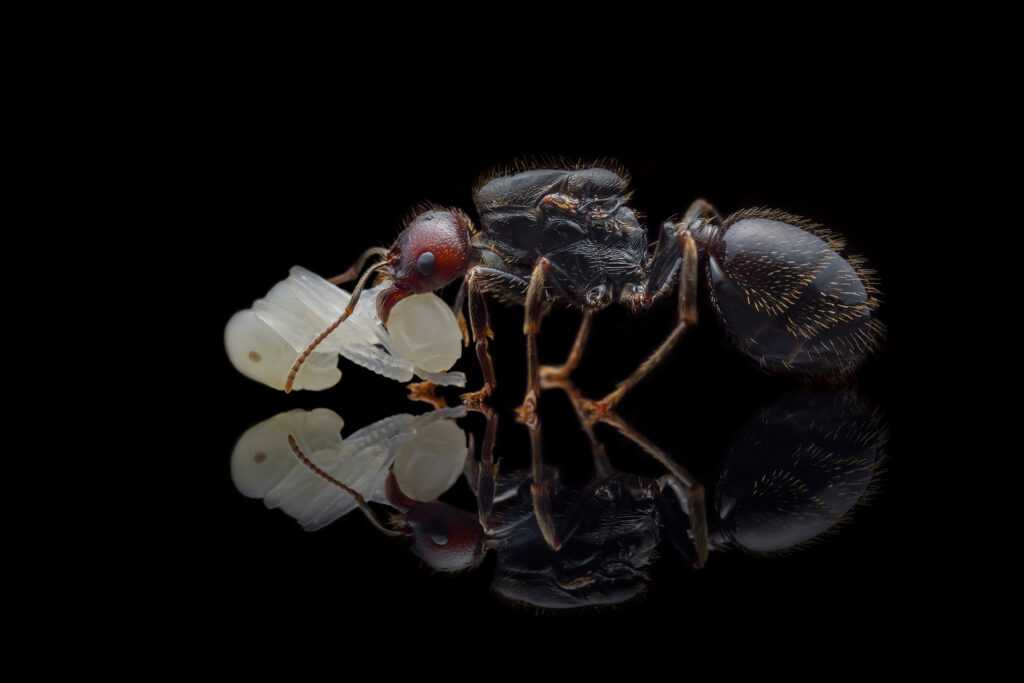Pogonomyrmex maricopa: The Red-Brown Powerhouse
Colony Dynamics
Pogonomyrmex maricopa, also known as the Maricopa harvester ant, is a fascinating species with a monogynous colony type. Each colony consists of a **single queen**. However, despite their monogyny, these mighty ants can build colonies of up to 20,000 individuals, making them a formidable force in the ant world.
Size Matters
When it comes to Pogonomyrmex maricopa, size plays a significant role in distinguishing the various members of the colony. The **queen**, the backbone of the colony, measures an impressive 11-12 mm in length. Workers, on the other hand, range from 5 to 9 mm. Despite their size differences, they all share a common **red-brown color**, albeit with varying intensities.
Nutrition: From Insects to Seeds
These diligent ants follow a diverse diet to sustain their impressive colony. Pogonomyrmex maricopa has a preference for feeding on **insects** such as cockroaches and crickets. However, they also rely on **seeds** as an essential source of nutrition. This dietary flexibility ensures their survival and optimal development.
Creating the Perfect Habitat
To maintain a healthy Pogonomyrmex maricopa colony, it’s crucial to provide them with an appropriate habitat that mimics their natural environment. For more information on ant habitats and other ant-related products, please visit AntOnTop.com.
Humidity
For the arena, which serves as the foraging area, a humidity level between 60-80% is ideal. However, in the nest, a higher humidity level ranging from 70-90% is necessary. This allows the ants to regulate their internal moisture levels and ensure the overall well-being of the colony.
Temperature
The temperature within the habitat is also a vital factor for the thriving of Pogonomyrmex maricopa. The arena should be kept at a comfortable temperature between 25-36 °C, while the nest requires a slightly cooler environment ranging from 22-26 °C. By maintaining these temperature ranges, you can help the ants stay active and promote their overall growth.
The Power of a Sting
Pogonomyrmex maricopa is known for its formidable sting, considered to be one of the most powerful among all ant species. This feature serves as a defense mechanism for the colony, allowing them to protect their precious queen and resources from potential threats. As fascinating as it is, it’s important to exercise caution and respect when observing or working with these ants.
Choosing the Right Nest
Pogonomyrmex maricopa requires a suitable nest for breeding, and several materials satisfy their needs:
- Acrylic
- Cork
- Plaster
- Aerated concrete
These materials provide a suitable environment where the ants can establish their chambers and carry out their daily activities. It’s crucial to maintain a humidity gradient within the nest, as some chambers must remain dry while others require a higher level of moisture. This allows the ants to regulate their internal humidity and ensure the optimal conditions for the growth of the colony.
In Conclusion
Pogonomyrmex maricopa, the red-brown powerhouse, is a captivating species that showcases the marvels of nature’s colony dynamics. With their monogynous colony type and impressive colony size of up to 20,000 individuals, they are a force to be reckoned with in the world of ants. Their diverse diet of insects and seeds ensures their nutritional well-being, while the ideal humidity and temperature within their habitat create an optimal environment for growth and thriving. With their powerful sting and unique nesting requirements, Pogonomyrmex maricopa truly stands out among its ant counterparts. So, if you’re seeking a captivating ant species to observe and learn from, look no further than Pogonomyrmex maricopa – a true marvel of nature.



















Reviews
There are no reviews yet.